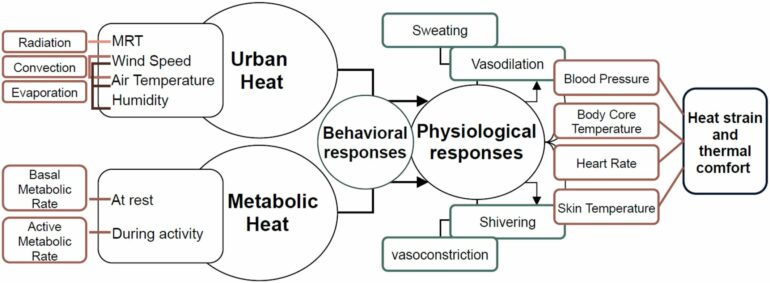Global warming and urbanization are expected to increase heat hazards in cities around the world, but higher temperatures may not always lead to higher health risks, according to a new study in Earth’s Future.
Health risks associated with extreme indoor and outdoor heat and humidity are influenced by physiological, socio-political and economic factors that vary between and within cities, such as physiological adaptation to heat, access to cooling infrastructure and age. The new study finds overheating thresholds around the world are best tuned to a hyperlocal, neighborhood scale defined by changing demographics.
“If we lump everyone together and say everyone is exposed to this one air temperature that we’re recording at the airport, then we’re missing a lot of the actual exposures to heat,” said Jennifer Vanos, study author and biometeorologist at Arizona State University.
“We can get citywide estimates on what an increase in air temperature might mean for the population, but if we can get finer-scale estimates and start thinking about people’s activity patterns and what they’re exposed to, then we can start to create better solutions that are more specific to that individual or to that sub-population.”
While prior studies have examined urban overheating regionally, the new study recommends combining environmental, behavioral and mobility data locally to better characterize overheating exposure and vulnerability levels.
With hyperlocal data, heat exposure can be tied to vulnerabilities within subcommunities, making heat risk mapping more human-centered, according to the study.
“There are so many integrated feedback loops when a heat wave comes in that we cannot think in a silo anymore,” said Vanos. “It’s not just about air temperature. It’s about all these other interacting factors that are affecting people in very different ways.”
Feeling the heat
Cranking up the air conditioning to maximum comfort levels makes hot outside summer weather feel even hotter. But this isn’t just perception: Continuously cooling indoor spaces limits the body’s ability to adapt physiologically to heat, raising the risk of dangerous health outcomes, the researchers said.
The study recommends people avoid being sedentary in air-conditioned spaces for long periods of time, as this reduces their aerobic fitness and tolerance to heat.
People who live in hot climates are more likely to feel comfortable at higher temperatures, the researchers said. This is for two reasons: climate acclimatization, which occurs when the human body physiologically adapts to a new environment, and thermal comfort, which is how hot or cold an environment feels based on someone’s own perception, experiences and expectations, Vanos said.
“An example of that this summer is in the U.K., there are heat waves of like 35 or 36 degrees Celsius,” said Negin Nazarian, lead study author and urban climatologist at University of New South Wales.
“On Twitter, people in Australia were sharing that ’35 degrees is just a normal summer day here,’ but what they’re not understanding is 35 degrees for the U.K. is completely different than 35 degrees in Australia because people are used to different background climates, buildings are built differently, and people have different information because they may be less exposed to those events.”
Urban heat-stress inequality
Certain communities may disproportionately experience negative health consequences from extreme heat, such as outdoor workers, people living outdoors, young and old people, and people with underlying health conditions. Heat hazards also pose an increased health risk for ethnic minorities and poor communities who may lack the necessary resources to adapt to their indoor and outdoor environments.
“This has really come to light in the U.S. in terms of historical planning practices,” said Scott Krayenhoff, study author and environmental scientist at the University of Guelph. “White and wealthier neighborhoods often have a lot of trees and greenery, and non-white or lower-income neighborhoods often don’t, so people’s exposure and ability to withstand heat differs geographically with how neighborhoods and cities are built and their capacity to adapt, both at the individual and municipal level.”
In addition to community-based risk factors, the study recommends prioritizing personal heat exposure, since individuals may have unique vulnerabilities.
“What I really like about this study is that it has an approach that considers the individual, not just the community as a whole,” said Susanne Benz, geographer at Dalhousie University who was not involved in the study. “There isn’t one heat threshold that we shouldn’t go above for every person. That heat threshold is different, and we need to be respectful of each other and basically take care of the people who maybe don’t have as high of a threshold because of illness or age.”
Furthermore, the study recommends that urban energy systems, including electrical grids, buildings and cooling mechanisms, can be more equitably designed to improve human health and well-being. For example, the paper offered lower cost, lower energy options to achieve comfortable temperatures indoors such as natural ventilation and fans.
“In an effort to address heat challenges in cities, private property developers can create modern, high-priced buildings that rely on air conditioning and/or have integrated a range of vegetation and water features,” Nazarian said.
“But we also need to ask, who’s going to be able to afford the price tags and lifestyles that come with these developments? It’s likely not going to be the most vulnerable people. Having that discussion around inequality and access is critical. The question of heat exposure needs to be addressed together with all additional environmental and social inequalities that we face in our cities, which is a big focus for this paper.”
More information:
N. Nazarian et al, Integrated Assessment of Urban Overheating Impacts on Human Life, Earth’s Future (2022). DOI: 10.1029/2022EF002682
Provided by
American Geophysical Union
Citation:
Urban overheating risks are personal, study finds (2022, September 13)
